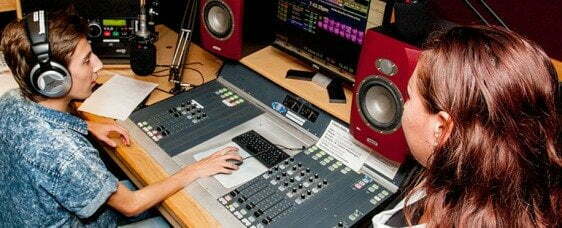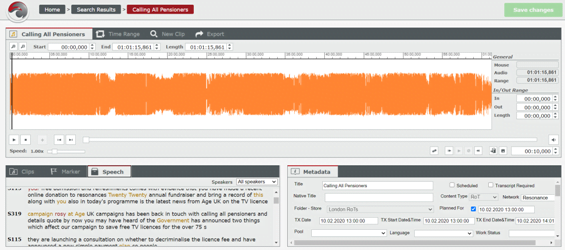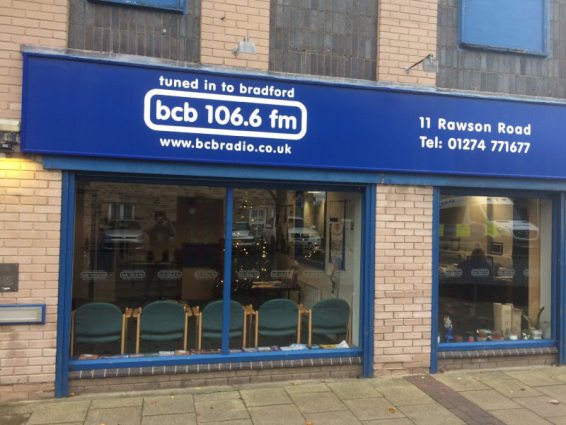
One medium that has shone out during the coronavirus pandemic has been radio. From the very start of the crisis, through lockdowns one and two, and life under tiers, radio – and I’m thinking particularly of community radio – has responded with alacrity and great enterprise. All media has responded to the pandemic with urgency and commitment, but radio has most notably lived up to all that is contained in the word ‘medium’.
What a time to have set up a pilot for a national radio archive. Four years ago I wrote here about the British Library’s plan to establish a two-year pilot project to record a representative selection of UK radio broadcasts, from national and local stations, capturing these off-air (i.e. the live broadcasts). The aim was to fill a significant gap in our national collections, as an estimated 92% or UK radio is not being preserved long-term, and a fair proportion of UK radio disappears soon after broadcast. Certainly anyone wanting to research current radio, or find good topics to research through such content, would have a difficult task. It seemed fitting to include what we called National Radio Archive (because we already have a National Television Archive, so it was good to make the connection) in the Library’s Save our Sounds preservation programme. You don’t just preserve the sounds of the past; you have to have plans in place to preserve the sounds of today, before they vanish from the ether.
That was 2016. The archive pilot was then scheduled to be underway in 2018, but there were delays over dry but essential matters such as procurement. By mid-2019 we had all of the equipment and software and agreements in place. We started trial recordings in September 2019. We launched our recording programme officially in January 2020, wondering what the year would bring.
The year of course brought us COVID-19. A crisis will bring a nation together, but people will invariably relate the news to its effect on their home and community. Many variations in impact meant that people thirsted as much for local as national information. This is where community radio found its voice. Local radio stations already were our particular focus in setting up the project, since none had the kind of resources enjoyed by BBC national and local radio to preserve output long-term. We did not have the money to preserve everything – and this was a pilot in any case – so we had to sample.

Constrained by the agreement we had with our software provider to select from no more than fifty stations at any one time, we decided to record regularly (and in some cases 24/7, or close to that) from some stations, and switch around others over the year, usually recording a few hours per day from each. So it is that we have recorded from sixty-four stations over 2020: seven BBC nationals, three BBC nations and the World Service, ten BBC locals, twelve commercial, two internet-only, and twenty-nine community or RSL (restricted service licence, such as hospital radio). As said, this is only a sample: there are over 700 licensed radio stations in the UK, of which currently 304 are from the community radio sector.
The community stations include Academy FM (Folkestone), All FM (Manchester), Bradford Community Broadcasting (whose inventive response to the pandemic has been especially noteworthy), CHBN (Truro hospital/community radio), East Leeds FM (aka Chapel FM, a channel revived in response to local need), Fix Radio (community radio for the building trade – particularly illuminating), Future Radio (Norwich), Panjab Radio (West London), Reprezent (South London youth-led station), Resonance FM (arts-based station), Radio Reverb (Brighton/Hove), Siren (Lincoln student/community) and Ujima (Bristol). Most of these I had never heard of before we started the project; quite a few I have yet to sample even now (happily I have colleagues with the rare skill of being able to listen to radio and document it at the same time).
Map of UK community radio stations and Community Media Association members
Though inevitably there is some music programming, for the most part we are capturing speech radio – news programmes, phone-ins, interviews, discussions etc. For this we are selectively utilising speech-to-text software (the value of which I have been going on about for ten years or more – at last the British Library is getting there), to make the programmes word-searchable and facilitate thematic cross-linking with other items in the Library’s collection. This is not just about preservation; it’s about enriching research. Radio has so much to offer scholars beyond those in radio studies. The medium’s response to COVID-19 alone proves this.
Community radio has not always been looked upon as a worthy news medium. Few employ trained journalists or have the resources to support a conventional news service. They have viewed in the past as providing chat rather than solid information. But in 2020 this has turned into a strength. A Brunel University report on UK community radio’s response to the pandemic says:
Arguably, the current crisis has proved that this softer style of information provision has been a really useful and workable solution to the need to keep local residents appraised of the latest happenings as the COVID-19 situation unfolds around them. The community sector seems to be gaining ground in becoming the nation’s trusted local radio provider. It may be staffed primarily by unpaid practitioners – ‘amateurs’ – but it cannot be categorised wholesale as amateurish. Care is taken to check for accuracy when sourcing and sharing important, timely and relevant information that is both of interest to their listeners and in their interest. The Broadcasting Code and libel laws can usually be relied upon to guide even volunteer radio presenters and reporters in their work on community radio stations

It hasn’t always been easy to keep up with such programming. Thrown into chaos by staff in many cases being forced to work from home (and many of them volunteers in the first place), DIY equipment, schedules regularly overturned, having to respond with fleetness to changing situations, it has taken much checking and amending of programmes captured to ensure that what we have recorded and the data that we have for it correctly match (we have had to improvise in similar fashion to the stations – much of our archiving has been managed from a colleague’s room in Hastings). We live in an era of automated metadata, which would seem to make the task of capturing a born-digital archive simplicity itself. In practice, because human beings and real life must intervene in the process, constant watchfulness is needed. Laborious as this may be, it is also in some ways quite reassuring. Humans make their mark through the mess that they create.
Radio at this time has differed from the other news media. All inform while they entertain, but radio, because it both speaks to us and can follow us around, has something else. It is medium between the media. It inveigles itself into the household conversation. In this crisis, it has guided through sociability. On the community level it has understood its audience as people, rather than statistics. These have been radio times.
Links:
- There is more information on the National Radio Archive project page and on the Sound & Vision blog. There is no public access to the NRA (we are reclaiming those initials for own own) as yet, and when we do complete the ‘front=end’ work, access for the most part will be onsite at the British Library only, for obvious reasons of copyright
- Though the National Radio Archive project is something new, the British Library has a historic radio archive of some 250,000 recordings going back to the 1920s. A task for the future is to bring the two together, seamlessly
- Live streams for most UK national and local radio stations can be found via the BBC/commercial radio collaborative service, Radioplayer (with whom we have worked in developing the NRA)
- The Brunel University project is ‘UK community radio responses to COVID-19‘, the report from which is available on its website
- Among the many pieces written about the rise of local radio during the pandemic, a New York Times piece on British hospital radio, ‘The Tiny Radio Stations That Lift Spirits in Hospitals‘, has particular charm
- You can find out more about community radio in the UK through its representative body, the Community Media Association